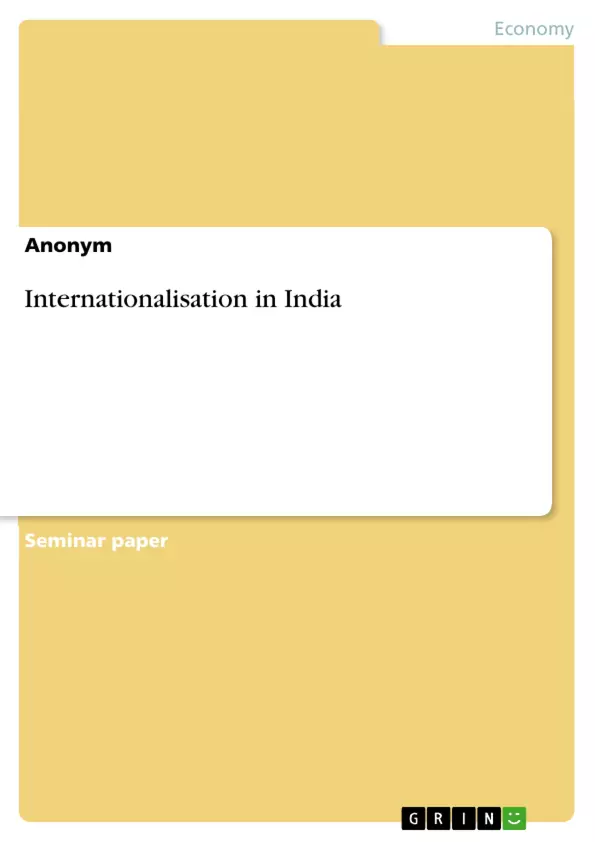This report explores the motivations, barriers, and modes of entry of SMEs internationalisation within a specific country context, with a focus on the Indian market. The report adopts three theories of internationalisation, namely the UPPSALA Model, the Eclectic (OLI) Model, and the Network Models, to demonstrate the various aspects of SMEs internationalisation. SMEs often lack the resources and capabilities of larger firms, which makes internationalisation a challenging process. Nevertheless, internationalisation offers significant benefits such as access to new customers and suppliers, increased market share, and opportunities for growth and innovation.
The case study of the Indian market is employed to explore the various modes of entry, barriers, and motivations that SMEs encounter in this developing economy. By studying these factors, researchers and practitioners can develop strategies to support SMEs in their internationalisation efforts and promote sustainable economic development. SMEs can leverage their resources and capabilities, such as innovative product offerings, cost-efficient production processes, and unique marketing and distribution channels, to gain a competitive advantage and succeed in international markets. Overall, exploring the motivations, barriers, and modes of entry of SMEs within a specific country context is essential for understanding the unique challenges and opportunities that businesses face in different markets and promoting their sustainable growth.
Inhaltsverzeichnis (Table of Contents)
- Abstract
- 1.0 Introduction
- 1.1 UPPSALA Model
- 1.2 Eclectic (OLI) Paradigm
- 1.3 Network Model
- 2.0 International Strategies, Motivations, Barriers and Modes of Entry into Foreign Markets; Case Study of India.
- 2.1 Modes of Entry into Foreign Markets
- UPPSALA Model
- OLI Model
- Network Model
- 2.2 Motivations for Taking a Business Global
- 2.3 Barrier of Entry into Foreign Markets
- 3.0 Conclusion
- References
Zielsetzung und Themenschwerpunkte (Objectives and Key Themes)
This report aims to investigate the motivations, barriers, and modes of entry associated with SMEs internationalizing within a specific country context, specifically focusing on the Indian market. By employing three established theories of internationalization – the UPPSALA Model, the Eclectic (OLI) Model, and the Network Models – the report explores the unique challenges and opportunities faced by SMEs in their quest for global expansion.
- The complexities of SMEs internationalization
- The application of theoretical frameworks to understand SME internationalization
- The Indian market as a case study for SME internationalization
- Motivations and barriers to internationalization for SMEs
- Modes of entry employed by SMEs in international markets
Zusammenfassung der Kapitel (Chapter Summaries)
The report begins with an introduction, outlining the significance of SME internationalization and the need for a deeper understanding of the factors influencing this process. It emphasizes the challenges faced by SMEs, particularly their limited resources and capabilities, yet highlights the potential benefits, including access to new markets and growth opportunities.
Chapter 1 delves into three prominent theories of internationalization: the UPPSALA Model, the Eclectic (OLI) Paradigm, and the Network Model. It discusses the key features of each theory, providing examples to illustrate their application in practice.
Chapter 2 focuses on the specific case study of India, a developing economy with a large and growing market. It examines the different modes of entry employed by SMEs into the Indian market, including joint ventures, acquisitions, and greenfield investments. The chapter also explores the motivations behind SMEs’ decision to internationalize, including market access, cost reduction, and access to new technology. Finally, it discusses the various barriers to entry, such as political instability, regulatory hurdles, and cultural differences.
Schlüsselwörter (Keywords)
SME internationalization, internationalization theories, UPPSALA Model, Eclectic (OLI) Model, Network Models, modes of entry, barriers to entry, motivations, Indian market, case study, developing economy.
- Quote paper
- Anonym (Author), 2022, Internationalisation in India, Munich, GRIN Verlag, https://www.hausarbeiten.de/document/1461467


